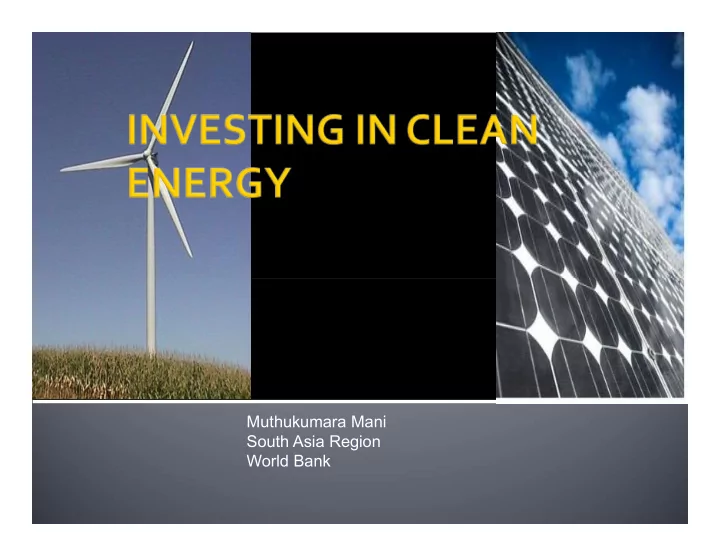

Muthukumara Mani South Asia Region World Bank
Continuing climate change at current rates will pose increasingly severe challenges to development and poverty reduction Under the “Paris Agreement” Countries are now committed to action to limit global warming to well below 2 degrees Celsius, and to make efforts to limit the increase to 1.5 degrees. increase to 1.5 degrees. Countries are encouraged to reach peak GHG emissions as soon as possible and achieve rapid reductions thereafter. Agreement seeks to achieve net zero GHG emissions between 2050-2099 Countries will prepare “Nationally Determined Contributions” (i.e. statements of emission reduction targets, current emission info, and adaptation priorities) every five years Mitigation measures more cost-effective in developing country context. Potential for low-carbon growth and co-benefits Scope for technological leapfrogging
Study Estimate WBGClean Energy Investment Framework US$30 billion/annum for power sector in (2006) developing countries UNFCCC (2007) US$200 -210 billon/annum OECD Environment Outlook (2008) US$350 - 3000 billion/annum IEA Energy Technology Perspective (2008) US$400 -1,100 billion/annum World Development Report (2009) US$140 to $175 billion a year over next 20 years for mitigation (with US$265-$565 billion associated financing needs) US$30 to $100 billion a year for adaptation
6,000 $5.9 $5.6 5,000 4,000 $3.4 $3.4 US$ Millions US$ Millions $3.3 $3.3 3,000 2,000 $1.8 1,000 - FY07 FY08 FY09 FY10 FY11 Energy Efficiency Renewable Energy Other Low Carbon 6
Requires massive scaling up From $9 bn to $170-$275 Bn A financing challenge: $250-$550 bn in A financing challenge: $250-$550 bn in associated mitigation finance It can be done Requires all options available Mitigation finance ~ 0.4% of rich country GDP
CDM-low volume, cumbersome approval process, carbon markets in disarray FDI-Dependent on Investment Climate (market-size, scale economies, infrastructure, governance, IPRs). ODA-Limited volume, influenced by political economy ODA-Limited volume, influenced by political economy considerations. Licensing- Investment and IPR climate, asymmetry in bargaining power, lack of capacities to manufacture and operate technology by domestic firms. Trade-Tariffs and non-tariff barriers, lack of complementary policies for market creation (govt. regulation, feed-in tariffs, finance, standards).
Private sector responsible for bulk of clean energy investments Need for creating a strong and credible international framework that will support appropriate national policies Public sector needs to plan an “activist” role in supporting and stimulating private action private action By implementing policies that indirectly encourage the purchase of clean energy (examples: pollution reduction targets, carbon cap-and-trade) By implementing policies that directly encourage the purchase of clean energy (examples: Renewable Portfolio Standards, Renewable Electricity Standards, and Energy Efficiency Standards) By directly purchasing renewable energy (examples: buying and installing solar panels on rooftops; installing wind turbines on military bases) Any government policy which ensures or encourages (or discourages) growth in market demand for clean energy will also encourage (or discourage) capital investment in clean energy generation.
By early 2011, at least 119 countries had some type of policy target or renewable support policy at the national level, up from 55 countries in early 2005 (around 76 countries have EE policies/standards). There is also a large diversity of policies in place at state/provincial and local levels. Developing countries, which now represent more than half of all countries with policy targets and half of all countries with renewable support policies, are playing an increasingly important role in advancing renewable energy.
Address key barriers that will improve the enabling environment for private sector investments in clean technologies. Help focus the catalytic public and donor resources towards helping Help focus the catalytic public and donor resources towards helping leverage the needed private sector resources. Provide valuable information to help guide and target private sector investment in clean power generation as well as ‘climate mitigation’ technologies.
General climate for doing business ( infrastructure, political and macro-economic stability, market-size, skilled and educated labor force, rule of law, financing and credit). Possible Climate-specific drivers: Domestic energy policy Possible Climate-specific drivers: Domestic energy policy and regulation (energy/carbon taxes, standards, pricing and subsidies), voluntary and binding commitments towards GHG reduction, access to information and transparency on climate investment opportunities, availability of climate finance including on concessionary terms (venture capital, commercial credit for climate investment), domestic carbon markets, IPR regimes, voluntary market-based incentives (labelling).
Renewable Energy Purchase Obligations (RPOs) and Tradeable renewable energy certificates Regulations Governing Access to Grid Transmission and ‘Wheeling’ Charges Equity-related restrictions Building codes Standards and labelling Standards and labelling Utility demand-side management programmes Public sector leadership programmes and public procurement policies Promotion of energy service companies (ESCOs) and energy performance (EPC) Energy-efficiency obligations and tradable energy efficiency certificates Technology research, development, demonstration and deployment (RD&D) Voluntary Commitments to Reducing GHGs
Grid-Connected Solar PV Grid-Connected Wind Country Score Country Score Philippines 10 Philippines 10 India 9.5 China 9 Czech Republic 8.5 Czech Republic 8.5 China 8.5 India 8.5 Italy Italy 8.5 8.5 Pakistan Pakistan 8 8 France 7.5 France 7.5 Spain 7.5 Spain 7.5 UK 7.5 Indonesia 7 Pakistan 7 Sri Lanka 7 Germany 6.5 Germany 6.5 Switzerland 6.5 UK 6.5 Indonesia 6 Thailand 6 Vietnam 6 Vietnam 6 Thailand 5 Switzerland 5.5 Sri Lanka 5 Italy 5.5
Clarity (policies and regulatory regime) Consistency Credibility (commitment) Clearances Clearances Compliance (with RPOs) Coordination (across agencies) Capacity Collateral (financing) Connectivity (grid access) Cartography (mapping/siting)
Private sector financing is key as we move towards a clean energy world But public sector should provide the enabling But public sector should provide the enabling environment for the private sector to thrive Not just on paper but also on implementation!
Muthukumara Mani: mmani@worldbank.org
Recommend
More recommend